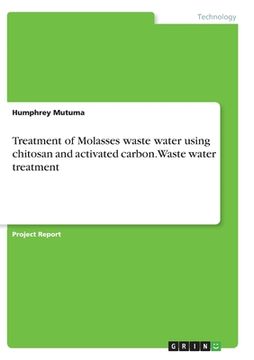Share
Treatment of Molasses waste water using chitosan and activated carbon. Waste water treatment
Humphrey Mutuma
(Author)
·
Grin Verlag
· Paperback
Treatment of Molasses waste water using chitosan and activated carbon. Waste water treatment - Mutuma, Humphrey
Choose the list to add your product or create one New List
✓ Product added successfully to the Wishlist.
Go to My Wishlists
Origin: U.S.A.
(Import costs included in the price)
It will be shipped from our warehouse between
Friday, July 19 and
Friday, July 26.
You will receive it anywhere in United Kingdom between 1 and 3 business days after shipment.
Synopsis "Treatment of Molasses waste water using chitosan and activated carbon. Waste water treatment"
Project Report from the year 2016 in the subject Engineering - Chemical Engineering, grade: 87, Moi University, language: English, abstract: This degree thesis studied the viability of treating molasses waste water using a combination of chitosan and activated carbon. Chitosan is obtained by deacetylation of chitin and is an important polymer in water treatment. Activated carbon is a powerful absorbent that is used in filtration. Effects of temperature, time, oh and agitation was studied. The research pointed important leads to embracing chitosan in waste water treatment. Kenya is a major sugar producer with a sugar production output of 591,658 tonnes. The sugar industry encompasses sugar refining which yields molasses used in molasses distilleries to produce ethanol. The molasses distillery produces distillery waste known as spent wash which has a high BOD/COD, bad odor and brown color. The high BOD/COD can be removed by conventional means such as aerobic and anaerobic digesters, but it is this brown caramelized compounds known as melanoidins that must be removed by unconventional means since they are recalcitrant and difficult to biodegrade biologically. This project aims to explore options of removing recalcitrant compounds in molasses waste water by adsorption process using powdered activated carbon and chitosan a biopolymer derived from chitin. Sugarcane molasses is the by-product of the sugar production industry which are generated during sugar production. Sugarcane molasses contains 50% fermentable sugar is dark brown, putrid and viscous liquid. Sugarcane molasses is a feedstock for ethanol production and is used in a ratio of 1:1 for fermentation and purification of spirit. The product collected as bottom products form spent wash which is the major constituent of molasses waste water. Properties of molasses include high acidity, strong odor, coloring pigments due to presence of melanoidins, metal sulfides and phenolics giving it brown color. Spent wash
- 0% (0)
- 0% (0)
- 0% (0)
- 0% (0)
- 0% (0)
All books in our catalog are Original.
The book is written in English.
The binding of this edition is Paperback.
✓ Producto agregado correctamente al carro, Ir a Pagar.

